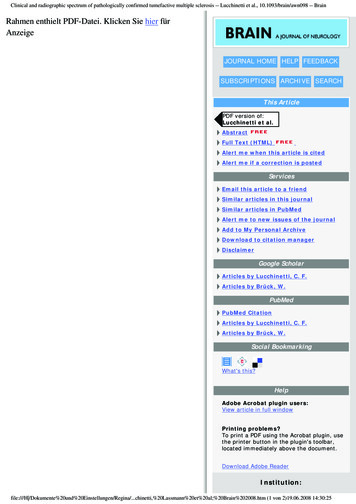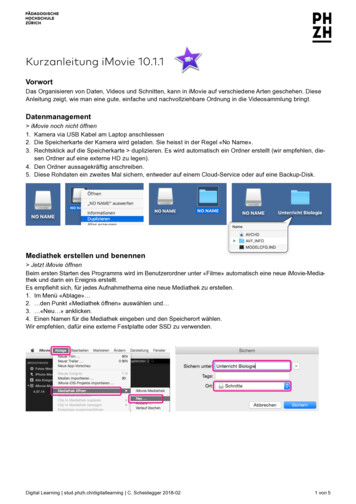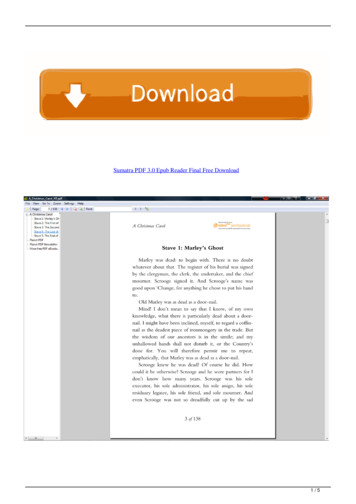
Transcription
Clinical and radiographic spectrum of pathologically confirmed tumefactive multiple sclerosis -- Lucchinetti et al., 10.1093/brain/awn098 -- BrainRahmen enthielt PDF-Datei. Klicken Sie hier fürAnzeigeJOURNAL HOME HELP FEEDBACKSUBSCRIPTIONS ARCHIVE SEARCHThis ArticlePDF version of:Lucchinetti et al.AbstractFull Text (HTML)Alert me when this article is citedAlert me if a correction is postedServicesEmail this article to a friendSimilar articles in this journalSimilar articles in PubMedAlert me to new issues of the journalAdd to My Personal ArchiveDownload to citation managerDisclaimerGoogle ScholarArticles by Lucchinetti, C. F.Articles by Brück, W.PubMedPubMed CitationArticles by Lucchinetti, C. F.Articles by Brück, W.Social BookmarkingWhat's this?HelpAdobe Acrobat plugin users:View article in full windowPrinting problems?To print a PDF using the Acrobat plugin, usethe printer button in the plugin's toolbar,located immediately above the document.Download Adobe ReaderInstitution:file:///H %20Lassmann%20et%20al;%20Brain%202008.htm (1 von 2)19.06.2008 14:30:25
Clinical and radiographic spectrum of pathologically confirmed tumefactive multiple sclerosis -- Lucchinetti et al., 10.1093/brain/awn098 -- BrainBibliothek der MedUniWienSign In as Personal Subscriberfile:///H %20Lassmann%20et%20al;%20Brain%202008.htm (2 von 2)19.06.2008 14:30:25
Brain Advance Access published June 5, 2008doi:10.1093/brain/awn098Brain (2008) Page 1 of 17Clinical and radiographic spectrum of pathologicallyconfirmed tumefactive multiple sclerosisC. F. Lucchinetti,1 R. H. Gavrilova,1 I. Metz,2 J. E. Parisi,3 B. W. Scheithauer,3 S. Weigand,4 K. Thomsen,4J. Mandrekar,4 A. Altintas,5 B. J. Erickson,6 F. Ko«nig,2 C. Giannini,3 H. Lassmann,7 L. Linbo,1 S. J. Pittock1 andW. Bru«ck21Department of Neurology, Rochester, MN, 2Department of Neuropathology, Institute for Multiple Sclerosis Research,Georg-August University, Gottingen, Germany, 3Laboratory Medicine and Pathology, 4Health Sciences Research,Rochester, MN, 5Department of Neurology, University of Istanbul, Istanbul, Turkey, 6Radiology, College of Medicine,Rochester, MN and 7Center for Brain Research, Medical University of Vienna, Vienna, AustriaCorrespondence to: Claudia F. Lucchinetti, Mayo Clinic, Department of Neurology, College of Medicine, 200 First St SW,Rochester, MN 55905, USAAtypical imaging features of multiple sclerosis lesions include size 2 cm, mass effect, oedema and/or ringenhancement.This constellation is often referred to as ‘tumefactive multiple sclerosis’. Previous series emphasizetheir unifocal and clinically isolated nature, however, evolution of these lesions is not well defined. Biopsy may berequired for diagnosis.We describe clinical and radiographic features in 168 patients with biopsy confirmed CNSinflammatory demyelinating disease (IDD). Lesions were analysed on pre- and post-biopsy magnetic resonanceimaging (MRI) for location, size, mass effect/oedema, enhancement, multifocality and fulfilment of Barkhofcriteria. Clinical data were correlated to MRI. Female to male ratio was 1.2 :1, median age at onset, 37 years,duration between symptom onset and biopsy, 7.1 weeks and total disease duration, 3.9 years. Clinical courseprior to biopsy was a first neurological event in 61%, relapsing remitting in 29% and progressive in 4%.Presentations were typically polysymptomatic, with motor, cognitive and sensory symptoms predominating.Aphasia, agnosia, seizures and visual field defects were observed. At follow-up, 70% developed definite multiplesclerosis, and 14% had an isolated demyelinating syndrome. Median time to second attack was 4.8 years, andmedian EDSS at follow-up was 3.0. Multiple lesions were present in 70% on pre-biopsy MRI, and in 83% by lastMRI, with Barkhof criteria fulfilled in 46% prior to biopsy and 55% by follow-up. Only 17% of cases remainedunifocal. Median largest lesion size on T2-weighted images was 4 cm (range 0.5 12), with a discernible size of2.1cm (range 0.5 7.5). Biopsied lesions demonstrated mass effect in 45% and oedema in 77%. A strong associationwas found between lesion size, and presence of mass effect and/or oedema (P 0.001). Ring enhancement wasfrequent. Most tumefactive features did not correlate with gender, course or diagnosis. Although lesion size 5 cm was associated with a slightly higher EDSS at last follow-up, long-term prognosis in patients with diseaseduration 10 years was better (EDSS 1.5) compared with a population-based multiple sclerosis cohort matchedfor disease duration (EDSS 3.5; P 0.001). Given the retrospective nature of the study, the precise reasonfor biopsy could not always be determined. This study underscores the diagnostically challenging natureof CNS IDDs that present with atypical clinical or radiographic features. Most have multifocal disease atonset, and develop RRMS by follow-up. Although increased awareness of this broad spectrum may obviateneed for biopsy in many circumstances, an important role for diagnostic brain biopsy may be required insome cases.Keywords: tumefactive multiple sclerosis; demyelinating disease; biopsy; pathology; MRIAbbreviations: ADEM acute disseminated encephalomyelitis; CSF cerebrospinal fluid; CT computed tomographic;EDSS expanded disability status scale; F/U follow-up; Gd gadolinium; IDD inflammatory demyelinating disease;IQRs interquartile ranges; MRI magnetic resonance imaging; OB oligoclonal bands; OC Olmsted County;PVWM periventricular white matter; T1W T1-weightedReceived December 5, 2007. Revised April 25, 2008. Accepted April 30, 2008ß 2008 The Author(s)This is an Open Access article distributed under the terms of the Creative Commons Attribution Non-Commercial License ) whichpermits unrestricted non-commercial use, distribution, and reproduction in any medium, provided the original work is properly cited.
Page 2 of 17Brain (2008)IntroductionMultiple sclerosis plaques on magnetic resonance imaging(MRI) generally appear as multiple, well demarcated,homogenous, small ovoid lesions, lacking mass effect andoften oriented perpendicular to the long axis of the lateralventricles (Paty et al., 1988; Barkhof et al., 2003). However,atypical imaging features have been described, which mayconfound the diagnostic process. These include a solitarylarge lesion, size 42 cm, associated mass effect, perilesionaloedema and/or the presence of ring enhancement (Riethet al., 1981; Sagar et al., 1982; Morimoto et al., 1985;Hunter et al., 1987; Gutling and Landis, 1989; Paley et al.,1989; Johnson et al., 1990; Nesbit et al., 1991; Youl et al.,1991; Giang et al., 1992; Kepes, 1993; Guadagnino et al.,1994; Maranhao-Fiho et al., 1995; Rusin et al., 1995; Dagherand Smirniotopoulos, 1996; Kurihara et al., 1996; Masdeuet al., 1996, 2000; Kumar et al., 1998; Al-Bunyan, 2000;Friedman, 2000; Censori et al., 2001; Khoshyomn et al.,2002; McAdam et al., 2002; Di Patre et al., 2003; Iwamotoet al., 2004; Wurm et al., 2004; Schwartz et al., 2006).Clinical presentations are dependent on lesion location andsize, and as a result are variable and include headache,cognitive abnormalities, mental confusion, aphasia, apraxiaand/or seizures. These atypical clinical and imagingpresentations may mimic brain tumour, cerebral abscessor other inflammatory disorders, and may necessitate abrain biopsy for diagnosis. Histologically, the biopsy maybe misinterpreted as a neoplasm given the hypercellularnature of these lesions and the frequent presence of atypical reactive astrocytes (i.e. Creutzfeldt-Peters cells) andmitotic figures (Zagzag et al., 1993; Annesley-Williamset al., 2000). A variety of terms including Marburg’s disease,fulminant multiple sclerosis, acute disseminated encephalomyelitis (ADEM), Balo’s concentric sclerosis, transitionalsclerosis, diffuse myelinoclastic sclerosis, pseudotumoralmultiple sclerosis and tumefactive multiple sclerosis havebeen used in the literature when referring to these cases ofCNS inflammatory demyelinating disease (IDD) (Niebleret al., 1992; Poser et al., 1992; Bolay et al., 1996; Chen et al.,1996; Dagher and Smirniotopoulos, 1996; Kim et al., 1997;Ernst et al., 1998; Iniguez et al., 2000; Capello et al., 2001;Karaarslan et al., 2001; Kotil et al., 2002). As a result, theliterature lacks uniform nomenclature or a clear, comprehensive description of the clinical and radiographicspectrum of CNS IDD with tumefactive features. This isdue to the limited number of cases available for study,frequent lack of pathological confirmation, and/or limitedclinical or radiographic follow-up (Nesbit et al., 1991;Kepes, 1993; Dagher and Smirniotopoulos, 1996; McAdamet al., 2002; Hayashi et al., 2003). Published seriesemphasize the unifocal and clinically isolated nature ofsuch tumefactive cases (Kepes, 1993). The purpose of thisstudy is to describe the clinical and radiographic presentations and outcomes in 168 patients with brain biopsyconfirmed CNS IDD. A better appreciation of the broadC. F. Lucchinetti et al.spectrum of clinical and radiographic features associatedwith CNS IDD may facilitate diagnosis, reduce unnecessarysurgical or medical interventions and ensure proper longterm management and treatment.Methods and MaterialsThis study, approved by the Mayo Clinic Institutional ReviewBoard (IRB # 2067–99), is a retrospective review of clinical,pathological and radiographic material amassed from patients withbiopsy proven CNS IDD identified from an original cohort of 780CNS IDD biopsy cases belonging to the multiple sclerosis LesionProject (MSLP). The MSLP database comprises a unique collection of biopsy-proven CNS IDD cases with detailed pathological,as well as both retrospective and prospective clinical and radiographic data and forms the basis of an international collaborativeeffort to study the pathologic, clinical and radiologic correlatesof the multiple sclerosis lesion (NMSS RG3184-B-3-02). Inclusioncriteria for the current study were: (i) brain biopsy performed aspart of diagnostic evaluation; (ii) pathological evidence ofconfluent inflammatory demyelination consistent with multiplesclerosis, confirmed by a certified neuropathologist (B.W.S., W.B.,H.L., J.E.P., C.G., F.K.) and (iii) a minimum of 1 MRI availablefor review. Specifically excluded were patients with ADEM pathologically defined as demyelination limited to perivenular areas(n 14) (Hart and Earle, 1975), as well as Devic’s neuromyelitisoptica defined based on published criteria (n 4) (Wingerchuket al., 1999, 2005). Also excluded were cases of neoplasm, infection, vascular or other non-demyelinating inflammatory CNSdisease, as well as prior history of brain irradiation. A total of168 patients identified from two medical centres; Mayo ClinicRochester, USA (n 127) and University of Göttingen, Germany(n 41), met inclusion criteria.Clinical materialClinical information was obtained by certified neurologists (C.F.L.;I.M.), via medical record review (100%), personal interview andexamination (71%), patient letter or telephone contact (22%) andfamily or physician contact (6%). In 140 patients, there wassufficient clinical documentation obtained via either face-to-faceencounter and neurological examination (n 119 patients; 90Mayo; 29 Germany), or telephone interview (n 21 patients) inorder to establish birth date, gender, date of symptom onset, dateof index attack prompting biopsy, index and other attack symptoms, types and dates of multiple sclerosis treatments administered, estimated EDSS at index attack, date of last follow-up andEDSS at last follow-up. Clinical course at time of biopsy and atlast follow-up was categorized as first demyelinating event,monophasic, relapsing–remitting, secondary progressive, primaryprogressive or uncertain, when it was unclear if an episoderepresented a discrete attack (e.g. seizure). Patients were classifiedas having definite or probable multiple sclerosis at last follow-upby either McDonald or Poser criteria (Poser et al., 1983;McDonald et al., 2001). Patients with a single neurological episode at last follow-up were classified as an isolated demyelinatingsyndrome. Clinical course of multiple sclerosis was based on wellaccepted criteria for relapsing–remitting, secondary progressive, orprimary progressive multiple sclerosis (Lublin and Reingold,1996). When available, pre-biopsy cerebrospinal fluid (CSF)results were recorded, including white blood cell count/mm3,
Spectrum of inflammatory CNS demyelinationtotal protein (mg/dl), intrathecal synthesis rate (normal orelevated) and presence or absence of CSF oligoclonal bands(OB). In addition, visual, brainstem auditory and somatosensoryevoked responses performed prior to biopsy were recorded asnormal or abnormal.Median EDSS at last follow-up in the biopsied cohort wascompared with a population-based prevalence cohort consisting ofpatients with definite (n 201) and/or probable (n 14) multiplesclerosis (using Poser’s criteria), who were residents of OlmstedCounty (OC) on December 1, 2000 (none underwent brainbiopsy) (Mayr et al., 2003; Pittock et al., 2004).Pathological materialHistopathology was available in all 168 cases. A brain biopsy hadbeen performed at an outside institution in 87% of the cases, andsent for extramural consultation to a study centre. All biopsieswere performed between September 11, 1987 and August 13, 2005,with over 1/2 performed since May 6, 2000, likely reflecting theexpanding Mayo and University of Göttingen extramural consultative practices. In all instances, the specimen was reviewed byat least one board certified neuropathologist. In 20 patients, asecond biopsy was obtained, and in a single patient, a third biopsyperformed. Since the majority of biopsies were performed at otherinstitutions, tissue material was obtained retrospectively, typicallymonths to years after the biopsy date, and clinical follow-up wasdone by clinicians not originally involved in the care of the patientat the time of biopsy, it was not possible to determine the preciseindication for brain biopsy in most circumstances.Radiographic materialA total of 842 brain and 24 spine conventional pre-biopsy andfollow-up MRIs obtained on 168 patients were reviewed. Sincethis was a retrospective study, a variety of imaging techniques andscanners were utilized. However, in the 119 patients whounderwent a face-to-face neurological examination at follow-up,a standardized contrast enhanced MRI was also performed on aGE (General Electric Medical Systems, Milwaukee, WI) Signa1.5T MR scanner using birdcage head coils, a slice thickness of3 mm and no interslice gap. In all 168 patients, at least one MRIwas reviewed, with at least one pre-biopsy MRI available in 151patients (90%) and at least one post-biopsy MRI in 148 (88%)patients. Among those with a pre-biopsy MRI, 95% had aT1-weighted (T1W), 97% T2W, 69% FLAIR and 95% had aT1W gadolinium (Gd) sequence. Among those with a postbiopsy MRI, 98% had a T1W, 100% T2W, 93% FLAIR and 99%had a T1W Gd sequence.Prior to blinded data collection, the radiographic features wereinitially defined by consensus among the study investigators (B.E.,C.F.L., W.B., R.G. and I.M.), with all training sessions occurringat a single site (Mayo Clinic Rochester). Subsequently, blindedto the clinical data, a single investigator at each centre evaluatedthe MRIs at their respective institutions (R.G., Mayo; I.M.,Göttingen). Results for all MRI variables identified on 10 randomly selected patients were crossed to assess for agreement,which was confirmed on all measures of interest. Questionsregarding radiographic interpretations at either study centre wereadjudicated by a certified neuroradiologist (B.E.).Lesions identified on each brain MRI study were defined aseither the initially biopsied lesion (‘index lesion’), or as otherlesions, enhancing and non-enhancing. These were analysed for aBrain (2008)Page 3 of 17variety of radiographic features: location, number, size range(0.3–2 cm; 2.1–5 cm; 45 cm) of both the T2W margin to marginsignal abnormality and the discernible lesion size when it waspossible to differentiate discrete lesion borders from the surrounding oedema; actual size (cm) of the largest lesion on the scan,presence and grade of mass effect [mild sulcal effacement, moderate (minimal subfalcine or uncal herniation; 51 cm) or marked(41 cm subfalcine or uncal herniation)], presence and degree ofoedema [mild (51 mm from the lesion), moderate (1–3 cm fromthe lesion) or marked (43 cm from the lesion)], presence of T2Whypointense rim (defined as a discernible smooth complete thinborder of T2W hypointensity relative to the hyperintensity of boththe lesion centre and surrounding oedema), biopsy defect size(not detected or tract only; 55 mm; 5 mm–2 cm; 42 cm) andT1W intensity relative to normal appearing white matter(isointense, mild/moderate hypointense, severely hypointense,hyperintense). Enhancement patterns were defined as homogenous(uniform and solid enhancement throughout the lesion); ring-like(open-ring when opened toward the gray matter; closed ring whenhaving a complete circular border and incomplete ring or arcwhen only part of the lesion is bordered), or heterogeneous(variable and complex pattern and distribution of enhancement).In some patients with a heterogeneous enhancement pattern, morespecific enhancement patterns could be identified and includedthe following: diffuse and patchy; ‘fluffy/cotton ball’; nodularwith distinct areas of enhancement each 42 mm amongst nonenhancing areas and punctate enhancement characterized bydistinct areas of enhancement each 52 mm. Complex lesions, ormultiple MRIs performed during a given imaging interval couldresult in more than one enhancement pattern.MRI studies were also evaluated for whether and whenmultifocal non-enhancing and enhancing lesions developed, orwhether Barkhof criteria were fulfilled (Barkhof et al., 1997). SpineMRIs, although included for this analysis, were not analysed forthe various radiographic features detailed above. Visual comparison without registration of the first and last MRI study for agiven patient was also evaluated for the following radiographicfeatures: overall change in T2W and T1W lesion volume(unchanged, reduced; minimally to moderately increased, markedly increased); extent of confluent periventricular white matter(PVWM) disease (none, mild, moderate, severe); presence ofatrophy (none, focal, minimal global, moderate global, severeglobal) and overall change in PVWM disease and atrophy(unchanged, improved or minimally, moderately or markedlyincreased). In order to determine if patients with at least onelesion 42 cm on pre-biopsy MRI had a tendency to relapse withadditional large uni- or multi-focal lesions, we performed asubgroup analysis of the tumefactive radiographic course in thiscohort.Statistical analysisClinical data were recorded on case report forms and double-dataentered to create SAS version 9 data sets (SAS Institute, Cary, NC,USA). Radiographic data were entered into a Microsoft Excelspreadsheet shared between both study sites. All data were subjected to extensive internal consistency checks. Statistical analysesdescribing clinical data and comparing clinical outcomes to radiographic features were restricted to the 140 patients with detailedclinical data, whereas statistical analyses describing radiographicfeatures included all 168 patients in the cohort in order to increase
Page 4 of 17Brain (2008)C. F. Lucchinetti et al.Table 1 Clinical features of cohortFig. 1 Prototypical timeline for study participant. The pre-biopsyMRI interval represents the time between MRI 1 and brain biopsy,whereas the post-biopsy MRI interval represents the timebetween biopsy and last MRI (MRI 6). Although for most patientsthe symptoms leading to brain biopsy (index attack) representedthe first neurological event, in some cases, the neurological historyantedated the index attack (attack 1). At the time of the enrolmentvisit, 140 patients had a face-to-face neurological history andexamination, and underwent a standardized MRI study (MRI 5).Total disease duration was from the time of symptom onset(attack 1) to last follow-up.statistical power and ensure a complete representation of theradiographic spectrum. Given the variability in the number ofscans among patients, the unit of analysis was based on individualpatients rather than scans, thereby maintaining statistical independence among observations and giving equal weight to eachpatient. Imaging data from multiple studies per patient werecollapsed into a single observation per patient as follows: (i) apatient’s studies were first classified into time periods (pre-biopsy,concomitant with biopsy and post-biopsy interval); (ii) forpatients with 41 biopsy, the biopsy of interest was consideredto be the last biopsy; (iii) if a patient had 41 study in a givenperiod, no data reduction was necessary and (iv) if a person hadmultiple studies in the period, the patient’s values on a particularradiographic feature were aggregated by recording the maximalvalue for ordered variables, such as maximum lesion size observedin a period, greatest number of enhancing lesions on a singlestudy within a period or whether a feature was ever present duringthe period. Figure 1 shows a schematic of a prototypic patienttimeline and radiographic intervals of interest. Because not allsubjects had an appropriate study available during each interval ofinterest, the sample size or denominator depended upon thevariables being analysed.Radiographic features were described and analysed separatelyfor biopsied versus non-biopsied lesions. Continuous variableswere analysed using medians, interquartile ranges (IQRs) andranges. Associations between dichotomous variables were analysedusing a chi-square test or if counts were small, by Fisher’s exacttest. Two-sample comparisons of continuous measures wereperformed using Wilcoxon rank-sum tests. To evaluate associations between two ordinal variables, Spearman rank-order correlation, denoted by rs, was used. When one variable was binary andthe other ordinal, we used Armitage’s trend test. Kaplan-Meiersurvival curves were used to determine time to second relapse, andCox proportional hazards models were used to determine whetherspecific factors were associated with risk of developing a secondmultiple sclerosis event. Median EDSS at last follow-up was comparedbetween the biopsy and the OC multiple sclerosis prevalence cohortsusing a two sample Wilcoxon rank sum test performed separatelyamong those with a disease duration55, 5–10 and 4 10 years.Logistic and linear regression models were used to assess theassociation and/or confounding effect of clinical and radiographicvariables such as biopsy defect size, gender and steroids.Gender F : MAge at symptom onset (years)Disease DurationSymptom onset to biopsy (weeks)Symptom onset to last F/U (years)Clinical course prior to biopsy (%)First neurological eventRelapsing remittingSecondary progressivePrimary progressiveProgressive-relapsingUncertainClinical course at last F/U (%)MonophasicRelapsing remittingSecondary progressivePrimary progressiveProgressive-relapsingUncertainDiagnosis at last F/U (%)Multiple sclerosisProbable multiple sclerosisIsolated demyelinating syndromeUnknownEDSSAt time of index attackAt last follow-up1.2 :137 (8 69)7.1 (3.7, 28.6)3.9 (2.0, 9.0)612912162451111397091473.5 (3.0, 4.5)3.0 (1.5, 4.0)Note: values in parentheses are either minimum maximum orlower quartile, upper quartile.All tests were two sided and a P-value of 0.05 was used toindicate significant associations between variables. P-values werenot adjusted for multiple comparisons (O’Brien, 1983; Perneger,1998). However, we do report P-values to several digits so thereader may perform Bonferroni-type corrections if desired.ResultsClinical characteristics of the cohortTable 1 summarizes the cohort in terms of demographics,clinical course and diagnoses both prior to biopsy and atlast follow-up. Median age at symptom onset was 37 years.The index attack leading to brain biopsy was the first neurological event in the majority of patients (61%), and eight(5%) carried an established diagnosis of multiple sclerosisprior to biopsy.Index attack symptoms were typically polysymptomaticand summarized in Fig. 2, with motor (50%), cognitive(43%), sensory (36%), cerebellar (31%) and brainstem(24%) symptoms being most common. A spectrum ofcognitive symptoms was observed, including encephalopathy or confusional state (19%), memory dysfunction(17%), aphasia (17%), apraxia (4%), Gerstmann syndrome(4%) and stupor/coma (2%). Visual field defects were seenin 10%, and seizures in 6%. There were no significantdifferences in index attack symptoms, including presenceof stupor/coma, encephalopathy or cognitive dysfunction,
Spectrum of inflammatory CNS demyelinationFig. 2 Neurologic symptoms at presentation. Cognitiveabnormalities were frequent, and included memory dysfunction,mental confusion and disorders of attention as well as disordersof higher cognitive function including aphasia (17%), apraxia (4%)and agnosia (4%).between patients developing multiple sclerosis and thosehaving an isolated demyelinating syndrome at lastfollow-up.Pre-biopsy CSF results were available on a subset ofpatients. Median protein in 58 patients was 40.5 mg/dl (IQR30.5, 60.0; range 11–383 mg/dl), with a median white bloodcell count/mm3 among 61 patients of 3.0 (IQR 2, 7; range0–117). In 22 of 62 patients (35%) IgG synthesis rate waselevated, and 20 of 60 (33%) had CSF OB. Pre-biopsyvisual evoked responses were prolonged in at least oneeye in 13 of 38 (34%) patients; brainstem auditory evokedresponses delayed in 3 of 13 (23%) and 15 of 25 patients(60%) had abnormal somatosensory evoked potentials.Most patients developed definite (70%) or probablemultiple sclerosis (9%) by Poser or McDonald criteria aftera median follow-up of 3.9 years (IQR 2.0, 9.0), with only14% having an isolated demyelinating syndrome at lastfollow-up. The latter patients were significantly older atsymptom onset than were those who developed multiplesclerosis (47 versus 36 years; P50.001). Although somepatients had a monophasic course (24%), a diagnosis ofmultiple sclerosis based on McDonald criteria could still beestablished. The estimated median EDSS at time of indexattack was 3.5 (IQR 3.0–4.5, range 0–9.5), and EDSS at lastfollow-up was 3.0 (IQR 1.5–4.0, range 0.0–9.5). Based onKaplan-Meier estimates, the median time to the secondattack was 4.8 years (Fig. 3). At last clinical follow-up,25% of patients had been treated with at least oneimmunosuppressive agent, and 63.5% had received one ormore disease modifying drugs.Brain (2008)Page 5 of 17Fig. 3 Kaplan-Meier estimates of the probability of remainingfree of a second attack among those whose biopsy was performedafter the first clinical episode (n 85). Solid line representsestimated probability, and dotted lines represent 95% CI. Themedian time to second clinical episode was 4.8 years. Therewere no specific risk factors (clinical or radiographic) identifiedwhich were associated with a greater risk of developing a secondmultiple sclerosis attack.Since patients in the biopsy cohort had a shorter meandisease duration than the population-based multiple sclerosis cohort (3.9 years versus 19 years), we analysed EDSSat last follow-up stratified by disease duration (Fig. 4).The biopsy cohort had a significantly lower median EDSScompared with the OC multiple sclerosis cohort amongpatients with disease duration 410 years (EDSS 1.5 versus3.5; P50.001), despite a slightly higher EDSS in patientswith 0–5 years (EDSS 3.0 versus 1.5; P 0.01) and 5–10years (EDSS 3.0 versus 2.0; P 0.04).Although our study lacked detailed cognitive assessmentat the time of last follow-up, based on EDSS evaluation weobserved that 22% of the cohort had a Cerebral FunctionalSystem’s score of 53 at last follow-up, reflecting moderateto marked decrease in memory.Pathological characteristics of the cohortBiopsies in all 168 cases demonstrated characteristic featuresof active inflammatory demyelinating disease, includinghypercellularity with myelin loss (Fig. 5A), reactive gliosis(Fig. 5B), Creutzfeldt cells (Fig. 5C), myelin protein-ladenmacrophages (Fig. 5D and E), variable lymphocyticinflammation and relative axonal preservation (Fig. 5F).Neoplasia was excluded in every case. The pathologicaldiagnosis was initially interpreted as a non-demyelinatingaetiology in 31% of cases by the referring pathologist.Among misdiagnoses (Table 2), a low grade astrocytomawas the most frequent (39%). Table 2 summarizes thepathological features in the cohort.
Page 6 of 17Brain (2008)C. F. Lucchinetti et al.Radiographic characteristics of the cohortA median number of five MRI studies were reviewedper patient (IQR 3–6; range 1–18). The median durations between imaging intervals are summarized inTable 3.Lesion numberFig. 4 Comparison of disability (most recent EDSS) betweenbiopsied cohort and OC multiple sclerosis prevalence cohortstratified by disease duration. The OC multiple sclerosis prevalencecohort is denoted by ‘OC’ and the current biopsy cohort isdenoted by ‘Bx’. Boxes extend to cover the middle 50% of the data.Median EDSS scores are indicated by the horizontal lines withineach box, mean scores by the diamonds. Whiskers extend tofurthest observation within 1.5 IQRs, with outlying points indicatedby individual circles. Although median EDSS at last follow-up wasslightly higher in the biopsy cohort compared with the OCmultiple sclerosis prevalence cohort in patients with diseaseduration between 0 and 5 years (3.0 versus 1.5; P 0.01), and5 10 years (3.0 versus 2.0; P 0.04), the EDSS was significantlylower in the biopsy cohort for 10 years (1.5 versus 3.5; P50.00
This study, approved by the Mayo Clinic Institutional Review Board (IRB # 2067-99), is a retrospective review of clinical, pathological and radiographic material amassed from patients with biopsy proven CNS IDD identified from an original cohort of 780 CNS IDD biopsy cases belonging to the multiple sclerosis Lesion Project (MSLP).










